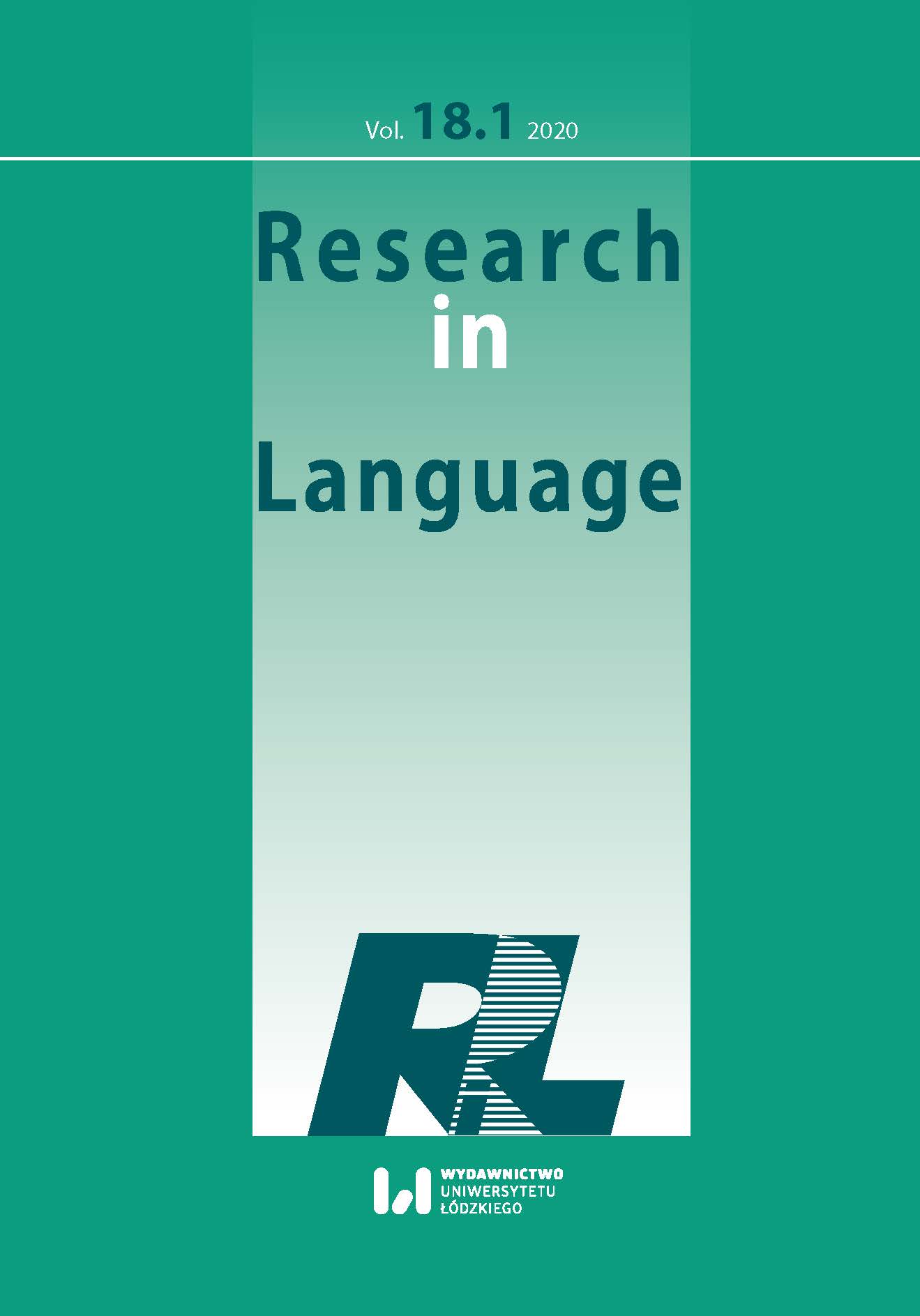Conflict – Crisis Hierarchy in English News Discourse: Cognitive Rhetorical Perspective
DOI:
https://doi.org/10.18778/1731-7533.18.1.04Keywords:
crisi, conflict, confrontation, English news discourse, cognitive rhetoricAbstract
The paper argues that in English on-line news the meanings of the conflict and crisis terms serve as reference points for the construction of a confrontation hierarchy. It is based on the interaction of the relations of force, serving as primes for meaning formation, with three levels of discourse prominence meant to attract, focus and keep the addressee’s attention in headings, headlines and throughout the text respectively. It is found that news stories arrange the units of conflict – crisis hierarchy according to three patterns: zoom-in, offering a detailed textual representation of confrontation with support of the argumentation sections of evidence, explanation or commentary; zoom-out, generalizing on the forces, underlying confrontation construction; multiperspectivation, aimed at a multifaceted representation of conflict – crisis hierarchy.
References
Adkins, Gabriel L. 2010. Organizational Networks in Disaster Response: An Examination of the US Government Network’s Efforts in Hurricane Katrina. In: W. Timothy Coombs and Sherry J. Holladay (eds.), The Handbook of Crisis Communication, 93-114. Oxford: Wiley-Blackwell. https://doi.org/10.1002/9781444314885.ch4
Google Scholar
DOI: https://doi.org/10.1002/9781444314885.ch4
Aczél, Petra. 2016. Virtual rhetoric. A theoretical approach. Res Rhetorica, 3(4), 1-15. Available from: https://resrhetorica.com/index.php/RR/article/view/168 [Accessed: 18th September 2020]
Google Scholar
Bitzer, Lloyd. 1968. The Rhetorical Situation. Philosophy and Rhetoric, 1, 1-14.
Google Scholar
Bray, Peter and Marta Rzepecka. 2018. Introduction. Communication and conflict. In P. Bray and M. Rzepecka (eds.), Communication and Conflict in Multiple Settings, 1-12. Leiden: Brill. https://doi.org/10.1163/9789004373679
Google Scholar
DOI: https://doi.org/10.1163/9789004373679
Browse, Sam. 2018. Cognitive Rhetoric: The Cognitive Poetics of Political Discourse. Amsterdam (Phil.): John Benjamins. https://doi.org/10.1075/lal.31
Google Scholar
DOI: https://doi.org/10.1075/lal.31
Burke, Michael. 2016. Discourse implicature, Quintilian and the Lucidity Principle: rhetorical phenomena in pragmatics. Topics in Linguistics, 17(1), 1-16. Available from: https://content.sciendo.com/view/journals/topling/17/1/article-p1.xml [Accessed: 18th September 2020] https://doi.org/10.1515/topling-2016-0001
Google Scholar
DOI: https://doi.org/10.1515/topling-2016-0001
Coombs, W. Timothy. 2010. Parameters for crisis communication. In W. T. Coombs and S. J. Holladay (eds.), The Handbook of Crisis Communication, 17-53. Oxford: Wiley-Blackwell.
Google Scholar
DOI: https://doi.org/10.1002/9781444314885.ch1
Cramer, Peter A. 2011. Controversy as News Discourse. Dordrecht, Heidelberg, London, New York: Springer Science + Business Media.
Google Scholar
Croucher, Stephen M. 2017. Changes in conflict over time. A longitudinal examination of conflict-style approaches. In B. Lewandowska-Tomaszczyk, P. A. Wilson, S. M. Croucher (eds.), Approaches to Conflict: Theoretical, Interpersonal, and Discursive Dynamics, 33-42. Lanham: Lexington Books.
Google Scholar
Dąbrovska, Ewa and Dagmar Divijak. 2019. Introduction. In E. Dąborvska and D. Divijak (ed.), Cognitive Linguistics Foundations of Language, 1-10. Berlin / Boston: Walter de Gruyter.
Google Scholar
Dancygier, Barbara and Eve Sweetser. 2014. Figurative Language. Cambridge: Cambridge University Press.
Google Scholar
Demmers, Jolle. 2012. Theories of Violent Conflict: An Introduction. London, New York: Routledge. https://doi.org/10.4324/9780203869512
Google Scholar
DOI: https://doi.org/10.4324/9780203869512
Dijk, Teun van. 1985. Structures of News in the Press. In Teun Dijk van (ed.), Discourse and Communication, 69-93. Berlin: De Gruyter.
Google Scholar
Freedman, Des. 2019. "Public service" and the journalism crisis: Is the BBC the answer? Television and News Media, 20 (3), 203-218. https://doi.org/10.1177/1527476418760985
Google Scholar
DOI: https://doi.org/10.1177/1527476418760985
Heath, Robert. 2010. Introduction. In W. T. Coombs and S. J. Holladay (eds.), The Handbook of Crisis Communication, 1-13. Oxford: Wiley-Blackwell.
Google Scholar
Holladay, Sherry. 2010. Are They Practicing What We Are Preaching? An Investigation of Crisis Communication Strategies in the Media Coverage of Chemical Accidents. In W. T. Coombs and S. J. Holladay (eds.), The Handbook of Crisis Communication, 159-180. Oxford: Wiley-Blackwell. https://doi.org/10.1002/9781444314885.ch7
Google Scholar
DOI: https://doi.org/10.1002/9781444314885.ch7
Hoxha, Abit and Thomas Hanitzsch. 2018. How conflict news comes into being: Reconstructing reality through telling stories. Media, War & Conflict, 11(1), 22-45. https://doi.org/10.1177/1750635217727313
Google Scholar
DOI: https://doi.org/10.1177/1750635217727313
Johnson, Mark. 1987. The Body in the Mind: The Bodily Basis of Meaning, Imagination, and Reason. Chicago, London: The University of Chicago Press.
Google Scholar
DOI: https://doi.org/10.7208/chicago/9780226177847.001.0001
Johnson, Mark. 2005. The philosophical significance of image schemas. In B. Hampe (ed.), From Perception to Meaning. Image Schemas in Cognitive Linguistics, 15-33. Berlin, New York: Mouton de Gruyter. https://doi.org/10.7208/chicago/9780226177847.001.0001
Google Scholar
DOI: https://doi.org/10.1515/9783110197532.1.15
Knoblock, Natalia. 2020. Introduction. In N. Knoblock (ed.), Language of Conflict: Discourses of Ukrainian Crisis, 1-15. New York: Bloomsbury Academic https://doi.org/10.5040/9781350098633.0005
Google Scholar
DOI: https://doi.org/10.5040/9781350098633
Kuypers, Jim. 1997. Presidential Crisis Rhetoric and the Press in the Post-Cold War World. Westport: Praeger Publishers.
Google Scholar
Kwiatkowska, Alina. 2012. From the editor. In A.Kwiatkowska (ed.), Texts and Minds: Papers in Cognitive Poetics and Rhetoric, 7-10. Frankfurt am Main: Peter Lang. https://doi.org/10.3726/978-3-653-04564-2
Google Scholar
DOI: https://doi.org/10.3726/978-3-653-04564-2
Makhotykh, Mykola and Maryna Sydorova. 2017. Social media & visual framing of the conflict in eastern Ukraine. Media, War & Conflict, 10 (3), 359-381. https://doi.org/10.1177/1750635217702539
Google Scholar
DOI: https://doi.org/10.1177/1750635217702539
LDOCE: Longman Dictionary of Contemporary English. Available from: https://www.ldoceonline.com/ [Accessed: 18th September 2020]
Google Scholar
OALD: Oxford Advanced Learner’s Dictionary. Available from: https://www.oxfordlearnersdictionaries.com/ [Accessed: 18th September 2020]
Google Scholar
Ojala, Marcus and Mervi Pantti. 2017. Naturalising the new cold war: The geopolitics of framing the Ukrainian conflict in four European newspapers. Global Media and Communication, 13, 41–56. https://doi.org/10.1177/1742766517694472
Google Scholar
DOI: https://doi.org/10.1177/1742766517694472
Pasitselska, Olga. 2017. Ukrainian crisis through the lens of Russian media: Construction of ideological discourse. Discourse and Communication, 11, 591-609. https://doi.org/10.1177/1750481317714127
Google Scholar
DOI: https://doi.org/10.1177/1750481317714127
Rzepecka, Marta. 2018. Analyzing President Obama’s crisis rhetoric: The case of Syria. Tekst i Dyskurs, 11, 405-425. Available from: http://cejsh.icm.edu.pl/cejsh/element/bwmeta1.element.desklight-b901e794-d90f-4558-8e26-e553e9951b51 [Accessed: 18th September 2020]
Google Scholar
DOI: https://doi.org/10.7311/tid.11.2018.18
Schnabel, Albrecht and David Carment. 2004. Mainstreaming conflict prevention: From Rhetoric to reality. In S. Albrecht and D. Carment (eds.), Conflict Prevention: From Rhetoric to Reality, vol. 1, 3-21. Lanbam: Lexington Books.
Google Scholar
Talmy, Leonard. 2000. Force dynamics in language and cognition. In L. Talmy (ed.) Concept Structuring Systems, vol. 1, 409-470. Cambridge (Mass): The MIT Press.
Google Scholar
Watanabe, Kohei. 2017. Measuring news bias: Russia’s official news agency ITAR-TASS’ coverage of the Ukraine crisis. European Journal of Communication, 32, 224–241. https://doi.org/10.1177/0267323117695735
Google Scholar
DOI: https://doi.org/10.1177/0267323117695735
Downloads
Published
How to Cite
Issue
Section
License

This work is licensed under a Creative Commons Attribution-NonCommercial-NoDerivatives 4.0 International License.










